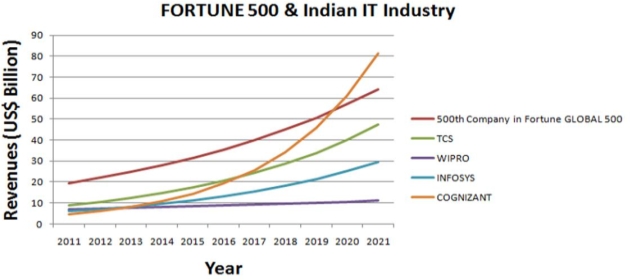ROYAL DUTCH SHELL (Netherlands) and MANPOWER (USA) respectively bring up the front and rear of the latest Fortune GLOBAL 500 list published in July 2012.
| RANK* | COMPANY | REVENUES (US$ Billion) |
PROFITS (US$ Billion) |
| 1 | ROYAL DUTCH SHELL | 484.49 | 30.91 |
| 500 | MANPOWER | 22.00 | 0.25 |
With growth rates of the Indian IT industry cooling down in the last couple of years, we thought it was time we revisited our last two predictions (here and here) about when an Indian IT company would enter the fabled list of the world’s 500 largest corporations.
When we plugged in the last two years’ revenues of the top four players into our model and extrapolated the figures through to 2021, this is what we got:
You can click here to download our Excel-based model.
According to the model:
- As predicted earlier, WIPRO and INFOSYS have very little chance of entering the Fortune GLOBAL 500.
- Surprisingly, even TCS will miss the list, at least until 2021, which is when our model ends.
- COGNIZANT is likely to join the FORTUNE 500 list by 2020. This assumes that the company continues to grow at the same scorching pace that it has during the last 2-3 years. A point about the company, though: Although the media regularly includes COGNIZANT in the Indian IT league table, it’s debatable whether it’s an Indian company – it’s headquartered in the USA, it’s not listed in the Indian stock market, and, in a recent bio, the company considers itself to be a “US group … headquartered in New Jersey”. It’s true that a majority of the company’s employees are located in India but that could be said of Accenture and IBM, two companies that nobody would consider Indian.
The above predictions assume that each company maintains its most recent year’s year-on-year growth rate well into the future. Since offshore IT services still have a large untapped market in many parts of Western Europe, we’re quite sure that growth will not slow down from the present level. As for the industry growing faster than now, the only way that could happen is if one or more of the leaders acquire large companies that are comparable to their own size, so that their revenues double going from one year to the next. We’re not saying that’s impossible but, going by the nature of the M & A deals that have happened in the industry over the years – including the recent takeover of Lodestone by Infosys – that seems highly improbable.
We wish we could conclude this post differently, but, for now, the Indian IT industry seems to have missed the Fortune GLOBAL 500 bus.
* For those looking up this list online, here’s a word of caution: According to the print version, this list is called RANK 2011, whereas, to pull up its online equivalent, you need to select 2012 – not 2011 – from the dropdown menu on the website. We tried pointing out this discrepancy to FORTUNE by emailing a letter to its editor at the usual email address, namely, editorfortunemail_letters@fortunemail.com, but our email bounced back saying no such address exists. It struck us at the same time that the “Letters to the Editor” section has been missing from the print magazine for the past several issues. Looks like FORTUNE doesn’t want to hear from its readers any longer.
